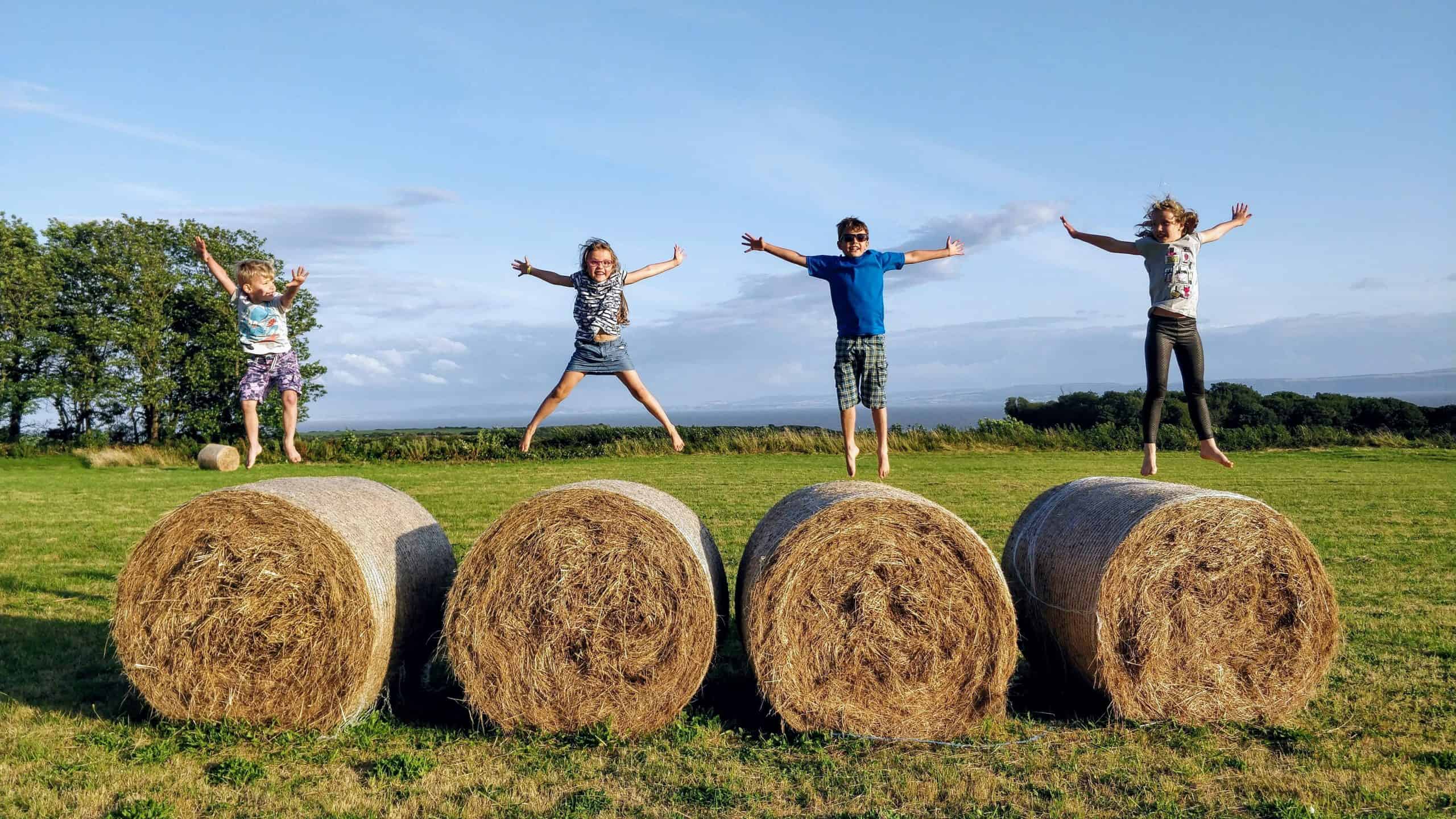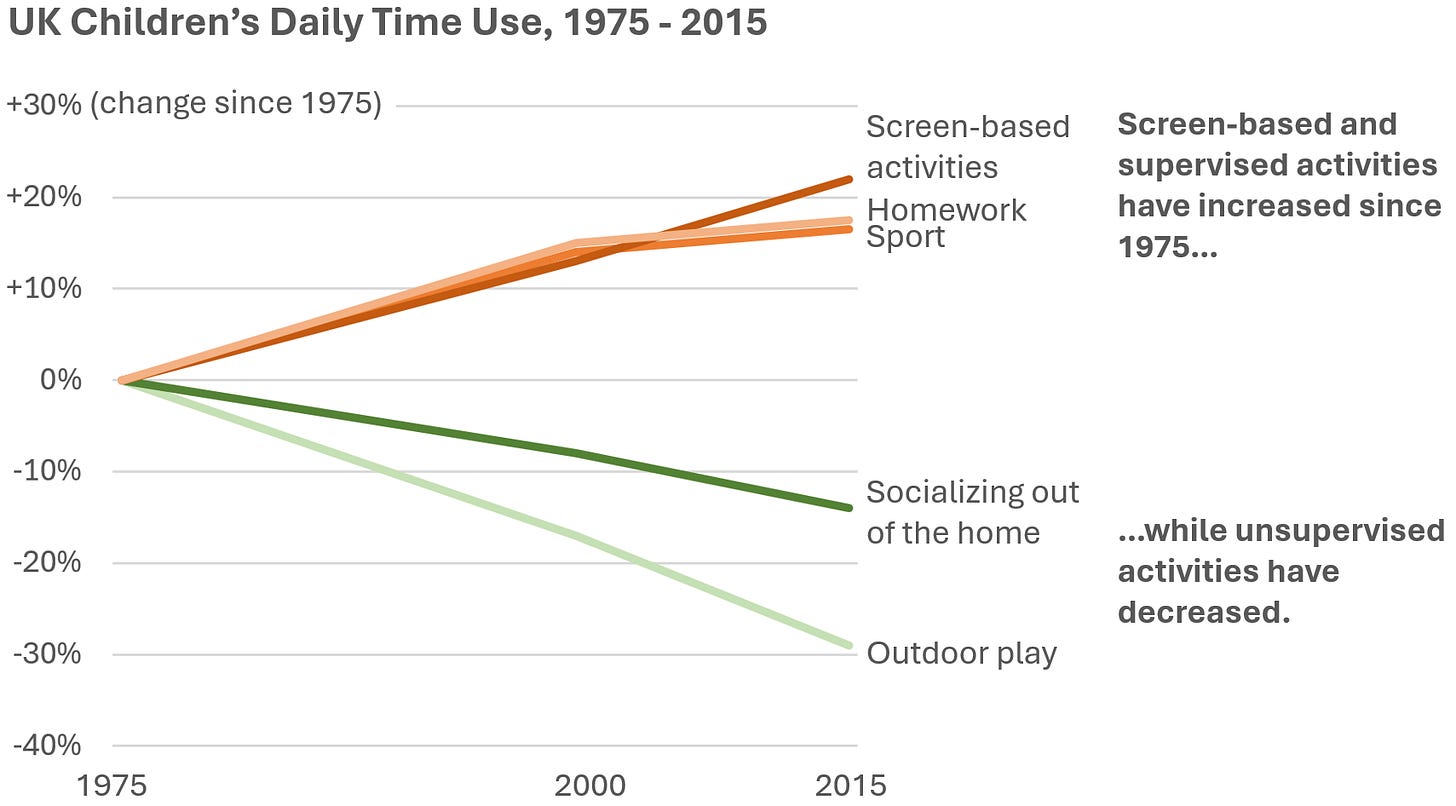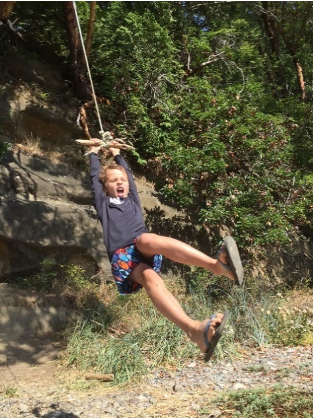
Why Children Need Risk, Fear, and Excitement in Play – And why adults’ fears put them at risk
This post was originally published on After Babel.
Thank you to Dr. Mariana Brussoni, Director of the Human Early Learning Partnership, University of British Columbia, for providing this post.
[Preface from Jon Haidt:]
In April 2023 I was invited to give a lecture at the University of British Columbia. As long as I was flying out to Vancouver, I wanted to meet Professor Mariana Brussoni, who had been writing important work on the value of outdoor risky play. Our hour-long meeting expanded my thinking about risk and play, and helped me write Chapters 2 and 3 of The Anxious Generation. Mariana quickly joined my pantheon of experts on play, along with Lenore Skenazy and Peter Gray. With articles such as Play Worth Remembering: Are Playgrounds Too Safe? and Risky Play and Children’s Safety: Balancing Priorities for Optimal Child Development, Mariana makes the case that we harm children’s social, physical, and even immune development when we remove all risk from their lives. I liked Mariana and her work so much that I gave her an open-ended invitation to write whatever she wanted at After Babel. Here is her essay, laying out her findings in a format that parents and schools can use. A concise summary of her work is this simple sentence, which she said to me during our meeting: “Children should be kept as safe as necessary, not as safe as possible.”
— Jon
We parents are caught in a paradox. We desperately want to keep our children safe and ensure their success. We are also often terrified that they will get hurt and that they will fail—so we do everything we can to prevent that from happening. Yet many of those very efforts to manage our fears have paradoxically reduced our children’s safety and their odds of success.
For over two decades, I have researched children’s development, injury prevention, and outdoor risky play. I have learned that when we prioritize children’s play (especially the kind of play that involves some risk and lack of supervision) and the freedom to play how they choose, we help create environments where children and youth thrive.1 When we don’t, the consequences can be dire.
Think back to your favorite childhood play memory. Where were you? What were you doing? Was there an adult supervising you?
Adults in many Western nations, particularly those born before the 1990s, recall playing with friends in their neighborhoods, local parks, and abandoned places, making up the rules as they went along, without adult supervision. They often recall a sense of joy, fun, and freedom as they would run, jump, and move their bodies in ways that weren’t allowed indoors. They felt independent, taking risks and figuring things out for themselves. And this is the kind of childhood that has been common for nearly all of human history. Children, like all young mammals, play.
Today, this kind of childhood is rare. Every successive generation of children since the 1970s has seen their outdoor play and freedom shrink. Time use data show that children’s leisure time has gone down, particularly time spent in unstructured outdoor play, while time spent in academic and screen-based activities has increased. Between 1975 and 2015, outdoor play among UK children decreased by 29.4%, while screen-based activities increased by 22.4%. In the U.S., only 16% of children in 1997 played outdoors every day. By 2003—just six years later—that dropped even further to 10%.

Figure 1. Changes in UK children’s daily time use, based on Mullan (2019). Thanks to Nick Desbarats for making this figure.
Just ask a young person (born after 1990) about their favorite childhood play memories. Then ask their parents the same question and you will see how this generational shift has played out. The parents will likely tell you stories of neighborhood adventures with friends. The child will likely talk about structured activities, such as sports—as they were under the watchful eyes of adults.
What Is Risky Play and Why Does It Matter?


Photos by Mariana Brussoni
Examples of risky play will be familiar to most of us: playing with heights (e.g., climbing), with speed (e.g., sledding), using tools (e.g., hammers, knives), playing near elements such as fire or bodies of water, rough-and-tumble play, play where children can wander independently (e.g., playing in their neighborhood with no adult supervision), and play with impact (e.g., jumping into a lake). This kind of play involves children pushing themselves beyond their previous limits and not knowing how things will turn out. As a result, they simultaneously experience thrill and fright. All children need risky play, but it may look different depending on the child.
Risky play, as the name implies, means that kids can get hurt, and that their chances of getting hurt are higher than if they’re more sedentary and playing quietly. On the surface, it’s not clear why a need for risky play would evolve across species, if it increases the chances that something bad will happen to those who partake in it. But when we dig a little deeper, its benefits become obvious. Risky play provides children with low-cost opportunities to develop the physical and cognitive skills to master the challenges that they will face as they grow older. So, those who engaged in it had a major evolutionary advantage over those who did not. Physically, risky play allows children to explore more diverse movements and gain physical movement skills. Cognitively, it helps them overcome their fears, build their critical thinking skills, and become accustomed to coping independently with difficult situations.
Risky play can even help children overcome anxiety disorders and the cognitive distortions that go along with them. Anxious children have difficulty tolerating uncertainty, tend to interpret ambiguity negatively and underestimate their ability to cope in uncertain situations. Through risky play, children practice dealing with strong ambiguous emotions (thrill and excitement could also be interpreted as fear and terror) and situations that abound with uncertainty. It can also show them that they are resilient and capable of coping when things go wrong. Research shows that children with more opportunities for risky play have lower internalizing symptoms that are characteristic of anxiety disorders.
In fact, the Canadian Paediatric Society sees risky play as so important, and as a way to address many of the challenges that their patients face, that they recently released a statement encouraging pediatricians to support it in patients’ lives.
With all of these benefits… and the evolutionary impulse for it… why has risky play been disappearing so rapidly?
Why is risky play disappearing from children’s lives?
This costly parenting strategy has negligible benefits at best, and can even be harmful. Research shows that enrollment in structured activities is not associated with improved developmental outcomes, and the loss of free time can be detrimental to developing basic executive function skills. When positive effects of intensive parenting have been shown, they’ve been modest and insufficient to offset the substantial costs to parents.3
So why does this parenting approach persist even though it is exhausting, parents wouldn’t have wanted it for themselves, and the research does not show benefits?
The answer lies in expectations. Parents today receive constant messaging that in order to be “good parents”, they must always keep their children safe. And it is widely believed that the world is no longer a safe place for children to play in. Yet statistics show that it has never been a safer time to be a child. Injury-related deaths are at an all-time low in most Western nations. In the US, deaths from unintentional injuries fell by 73% for boys and 85% for girls between 1973 and 2010. This misperception of risk creates the parental paradox.
What kids are dying from today are mainly car crashes and suicides, not playing outside unsupervised with friends. Parents are worrying about the wrong causes of injuries and harm. In fact, the very strategies that parents use to try to keep their children safe – driving them around, maximizing supervision, and minimizing freedom – are unintentionally increasing the likelihood of injuries and even death.
Three ingredients to bring back risky play and childhood freedom
The solutions are both simple and hard. We know what children need to thrive. The three key ingredients necessary for thriving play environments are Time, Space, and Freedom.
Time: Make daily outdoor playtime a priority. That can mean adding it to the schedule, much like we already do for sports or other extra-curricular activities. But schools should also take steps to prioritize outdoor instruction and recess. This can be particularly important for children from disadvantaged families without ready access to safe and stimulating outdoor environments. Parents and educators can use the U.S. Play Coalition’s position paper on recess to advocate for more recess in schools. My research lab also developed a free teacher tool to help encourage outdoor learning, which includes short how-to videos to help overcome common barriers that teachers face.
Space: Children need easy access to stimulating spaces for play; flexible spaces where they can use their imagination and explore risks, rather than spaces dominated by boring play structures and strict rules. Unfortunately, these kinds of spaces are harder and harder to come by as more parking lots and highways are built to accommodate a growing number of cars. At a legislative level, we need to move away from municipal planning that prioritizes cars over people–an important step that a number of North American cities have already taken. Outside of legislation, there is much that individuals can do, even with the little space that is available. For example, “loose parts” (e.g., sticks, lumber, rocks, boxes, and tarps) can turn boring and barren play spaces into places of joy and wonder. While these may look like junk to adults, children love them. Scotland developed a loose parts toolkit for anyone who wants to get started. Some cities also have adventure playgrounds—child-centered, child-directed play spaces that are rich in loose parts. (Such playgrounds always have adult staff on hand, but the staff stays in the background unless serious safety risks arise.). See New York’s play:groundnyc as one example.
Freedom: Children need freedom to be able to play the way they choose. The biggest barrier to children’s freedom is us—the adults in their lives—and our need to manage our own fears. Getting over these fears can be difficult, but it is much easier when you work together with other parents. Peter Gray suggests that building tighter relationships with neighbors can help parents feel more confident about letting their kids out to play. The U.S. organization Let Grow works with parents and schools to help support an independent childhood. For parents working to manage their fears and change their approach to play, our lab developed the OutsidePlay.org parent tool to help them work through their challenges, figure out what works best for them and develop a plan for change. We’ve tested it rigorously and it works.

Creating environments for children to thrive doesn’t have to feel overwhelming or unattainable. Every change begins with one small and manageable step. We each have to choose what this looks like for us. We owe it to our children to prioritize play and freedom in their lives and everyday realities. We’ve already seen what happens when we don’t. Let’s break out of the paradox, and give children the freedom they need to thrive.
To find more tools to help bring back risky play and to learn more about Mariana’s research, head to OutsidePlay.org.
This post was originally published on After Babel.
Cover photo by Josh Mills on Unsplash

